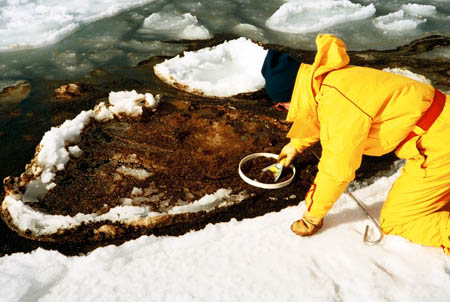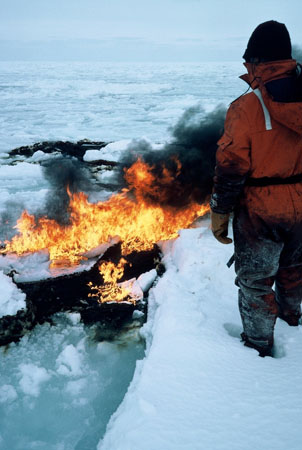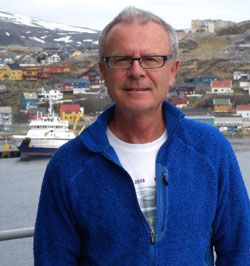
David Dickins
Projects: Oil Spills
Dickins specializes in oil spill research studies associated with offshore development activities and marine transportation. Projects cover the full range of risk analyses including accident frequency, spill consequences, preventive measures and oil spill response strategies.
Dickins played a major role in nine experimental spill programs in Canadian and Norwegian waters, including six in the Arctic and three off the Canadian East Coast. Findings from these projects including the pioneer experiment at Balaena Bay in 1974/75, still form the basis for much of the current knowledge about the behavior of oil spilled in cold water and arctic environments. In 1986, Dickins Associates produced the first comprehensive oil spill response atlas in Canada and went on to develop several other atlases covering critically sensitive marine environments in Lancaster Sound and the West Coast of British Columbia. Oil spill research projects linked to offshore oil developments and marine routes around the world include evaluating spill scenarios and response strategies in the US Beaufort and Chukchi Seas, Canadian Beaufort, West Coast of Canada, Northwest Passage, Sakhalin Island, Norwegian Barents Sea, Labrador Sea and Caspian Sea.
Over the past ten years, much of the company’s efforts have focused on managing research programs initiated under two large-scale joint industry projects: as a Research Partner in the SINTEF Oil in Ice JIP (2006-2010) and as a representative of the Chevron Arctic Center in the Arctic Response Technology JIP (2012-2016). In addition, from 2004 to 2012, DF Dickins organized and operated its own privately managed JIP with up to 5 oil company partners, aimed at developing radar systems for oil in ice detection.
Over the past three years (2014-15) David Dickins has played key roles in the completion of three prestigious high profile publications concerned with mitigating the risk of spills in an arctic environment through careful planning, and preparedness using the most effective response strategies.
The first: Responding to Oil Spills in Arctic Marine Environments was produced by a committee of the National Academy of Sciences to which David Dickins was honored as an appointee.
A second major project involved writing topic papers for the massive National Petroleum Council Council compendium submitted to the Secretary of Energy in July 2015. Dickins covered subjects dealing with remote sensing, ice environments, and in situ burning as well as preparing an overview of state of knowledge concerning oil spills in an arctic environment.
Released late in 2015, The Guide to Oil Spill Response in Snow and Ice Conditions in the Arctic is the most up to date and comprehensive work available on the subject – DF Dickins partnered with Owens Coastal Consultants to write and prepare the guide that is now serving as the basis for a second publication (2016) under the auspices of the International Maritime Organization.
Selected Oil Spill Projects
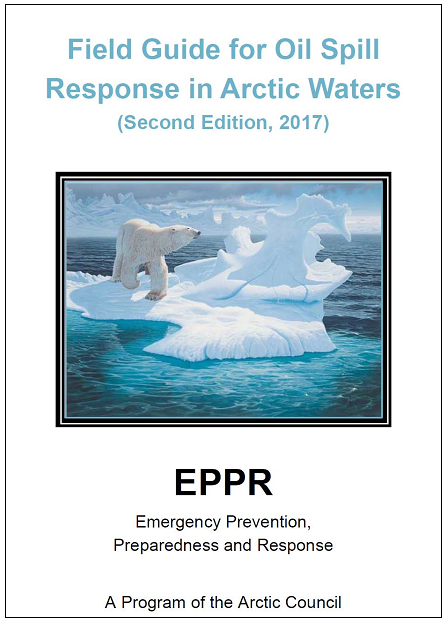
Field Guide for Oil Spill Response in Arctic Waters
(Second Edition, 2017)
The Arctic Council contracted the team of Owens Coastal Consultants, Counterspil Research, and DF Dickins to prepare a completely revised 2nd edition to the original field guide issued in 1998. The new volume contains reorganized and fully updated material to reflect advances in Arctic oil spill response over the past 20 years.
Download available at: https://oaarchive.arctic-council.org/bitstream/handle/11374/2100/EPPR_Field_Guide_2nd_Edition_2017.pdf?sequence=12

Topic papers are at http://www.npcarcticpotentialreport.org/topic-papers.html
The full report and executive summary are available at http://www.npcarcticpotentialreport.org/

The International Maritime Organization (IMO) and the Arctic Council working group for Emergency Preparedness and Response (EPPR) contracted the team of Owens Coastal Consultants and DF Dickins Associates to prepare a new, comprehensive Guide to Oil Spill Response in Ice and Snow Conditions. At 183 pages, the lavishly illustrated main report provides a unique insight into the issues and strategies surrounding the challenge of spill response in the Arctic.
https://oaarchive.arctic-council.org/handle/11374/403
IMO in London recently (2018) published a slightly edited version of the original Guide created by Owens and Dickins for sale under their own cover. New sections include Antarctica and other subarctic areas affected by ice.

NATIONAL ACADEMIES REPORT RELEASE
Responding to Oil Spills In Arctic Marine Environments, 2014
David Dickins was appointed in 2012 to National Research Council Committee: Responding to Oil Spills in Arctic Marine Environments. The Committee was charged with assessing the current state of science and engineering regarding oil spill response and environmental assessment in the Arctic region with a specific focus on Alaskan waters from the Bering Strait to the Canadian border. David Dickins developed chapters covering the ice environment, oil spill fate and behavior in ice and response strategies for spills into ice-covered waters.
The final report was publicly released in April 2014 through a series of briefings in Washington and Alaska and presentations at the International Oil Spill Conference in Savannah, Georgia, May 2014. David Dickins briefed the Ocean Studies Board of the National Academy in Irvine at their fall 2014 meeting.
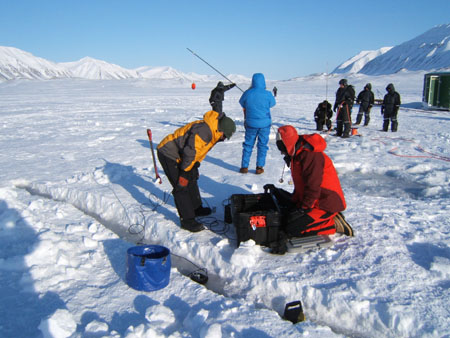
Arctic Response Technology Joint Industry Project
2012 to 2016
In January 2012, members of the international oil and gas industry launched a collaborative effort to enhance Arctic oil spill capabilities under the auspices of the International Association of Oil and Gas Producers (IOGP). This collaboration, called the Arctic Oil Spill Response Technology Joint Industry Programme (JIP) is aimed at expanding industry knowledge of, and proficiencies in Arctic oil spill response. Representing Chevron Canada and their Arctic Center in Calgary, David Dickins plays an active part in the day to day research activities of the JIP, representing the Chevron Arctic Center as chair of the Field Research Technical Working Group (TWG), co-chair of the Remote Sensing TWG and member of the Mechanical Recovery, Dispersants, In Situ Burn and Trajectory Modelling groups. This JIP is the most ambitious research programme of its kind ever attempted and follows the successful SINTEF Oil in Ice JIP carried out between 2006 and 2009. Dickins played a key role in that program as well, acting as research coordinator for Remote Sensing – see following.

Spill Response in the Arctic Offshore. Feb 2012.
Prepared for the American Petroleum Institute and the Joint Industry Programme on Oil Spill Recovery in Ice. Authors: Stephen Potter, Ian Buist and Ken Trudel – SL Ross Environmental Research; David Dickins – DF Dickins Associates LLC; and Ed Owens – Polaris Applied Sciences.
As co-author, Dickins prepared chapters dealing with ice conditions and remote sensing. This report is considered a basic reference summarizing all aspects of Arctic spill response and drawing on four decades of research. A summary of this report was prepared by the Arctic Response Technology Joint Industry Programme and is available for download at
The full report can be found at
https://www.dfdickins.com/pdf/Spill-Response-in-the-Arctic-Offshore.pdf

CRREL scientist Jackie Richter Menge measuring ice temperatures at the 2011 tests

John Bradford of Boise State University towing the GPR system over the oiled test hoops in the CRREL outdoor basin.
New Technologies for the Remote Sensing and of Oil in and Under Ice – Phase 4 Development of an Airborne Prototype
for the US Bureau of Safety and Environmental Enforcement (2010-11) and Industry Sponsors 2010 to 2012 – with Boise State University and AlloSys Corporation
From 2010 to 2012 Dickins Associates is led a further Joint Industry Project with five participants (ExxonMobil, Statoil, Shell, ConocoPhillips, and Alaska Clean Seas) aimed at developing an operational ground penetrating radar (GPR) that can detect oil trapped underneath or within sea ice from a low-level helicopter. Whereas previous phases utilized commercially-available impulse radars operating at a single frequency, the latest program focused on designing, building and testing an entirely new Frequency Modulated Continuous Wave Radar (FMCW) optimized for an airborne application.
The latest phases of developing radar for oil and ice detection were summarized in a poster presentation at the 2011 AGU Fall Meeting And a recent paper presented at the 2015 Arctic Technology Conference in Copenhagen Targeted Full-Waveform Inversion of Ground-Penetrating Radar Data for Quantification of Oil Spills under Sea Ice.
http://www.bsee.gov/Technology-and-Research/

Pollution patrol Dash 7 operated by Transport Canada on
Arctic surveillance missions during the summer and fall.
Photo: Wikipedia Commons
Beaufort Sea Oil Spills State of Knowledge Review and Identification of Key Issues
for SL Ross Environmental Research Limited (Client: Environmental Studies Research Funds) 2009-2010
Dickins was tasked to review the state of oil spill knowledge for technologies for spill surveillance and tracking and long-term monitoring in ice-covered waters as part of an overall assessment of advances in Arctic spill response practices since 1990.
Swedish Q300 aircraft used in the 2009 field experiment.
Photo: Swedish Space Corporation
SINTEF JOINT INDUSTRY PROJECT: Oil Spill Contingency in Ice for Arctic Waters 2006-2009
The Oil in Ice JIP was funded by a group of international oil companies to advance the response capabilities available to deal with accidental oil spills in ice. The program was coordinated and managed by SINTEF in Trondheim, Norway. DF Dickins Associates was a participating R&D organization charged with managing the remote sensing project within the overall program. Remote Sensing for the Oil in Ice Joint Industry Program 2007-2009
Following successful research cruises in the Norwegian Barents Sea in 2008 and 2009, the project came to a close in 2010 with a number of conference presentations in different locations around the globe (Tromso, Halifax and Anchorage). Joint industry program on oil spill contingency for Arctic and ice-covered waters – Summary Report
The Oil-in-Ice JIP was the most ambitious and complex Arctic spill research program attempted at the time and the results will guide oil spill response planning in future offshore development projects for years to come.
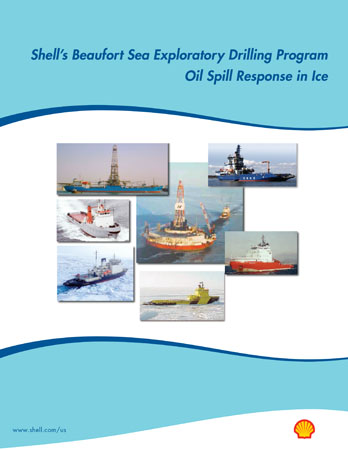
Shell’s Beaufort Sea Exploratory Drilling Program 2005-2007
for Shell Exploration and Production, Houston
DF Dickins provided engineering and technical support to Shell’s Beaufort Sea and Chukchi exploration programs, working directly through Shell’s Anchorage and Houston offices, ASRC Energy Services and Coastal Frontiers. Specialized services include advising on environmental issues as well as strategic planning for marine operations in ice and development of historical ice databases. As part of the permit and approvals process, Dickins worked with a long-time associate, Alan Allen of Spiltec to prepare a publication covering many aspects of oil spill response in ice. This report was produced by Shell E&P in October 2007 and distributed at the Oil & Ice Workshop in Anchorage.

Vertical thin section viewed through polarized light of an ice core taken from the SL Ross indoor ice tank.
Photo: Michelle Johnston – National Research Council Canada
Empirical Weathering Properties of Oil in Snow & Ice 2005-2008
for MAR Inc. (contract to Minerals Management Service)
Dickins assisted SL Ross Environmental Research of Ottawa in a three-year program of lab, tank and field tests to investigate the behavior of oil in snow and ice. The program funded by the US Minerals Management Service included experimental spills of oil on the surface and beneath the ice. Dickins’ involvement focused on examining trends between environmental variables and oil properties affecting the rate of oil migration (vertical rise) through the ice.

Flying the GPR attached between the helicopter skids.

Ground surveys with the GPR over an oil spill under the ice on Svalbard
New Technologies for the Remote Sensing and of Oil in and Under Ice – Phases 1, 2 and 3
for the US Minerals Management Service and Industry Sponsors 2004 to 2008 – with Boise State University
This work covers a series of successful projects through a long-term collaborative effort with the Boise State University Center for Geophysical Investigation of the Shallow Subsurface (CGISS).
Phase 1, completed successfully in 2004, proved for the first time that commercially available GPR systems operated from the ice surface could detect oil both trapped within the ice and pooled under the ice. Tests were conducted at CRREL’s cold basin in Hanover, NH. http://www.bsee.gov/Technology-and-Research/Oil-Spill-Response-Research/Projects/Project-517/
Phase 2 included field tests in 2005 confirming the ability to profile the bottom of the ice up to 1.8 meters thick (without oil) using commercially available GPR. The field program took place off West Dock, Prudhoe Bay along the ice road to Northstar. http://www.bsee.gov/Technology-and-Research/Oil-Spill-Response-Research/Projects/Project-547/
The GPR capabilities were confirmed under field conditions in April 2006 through a 3,500 liter experimental spill created on Svalbard through a joint venture with SINTEF, The University Centre in Svalbard (UNIS) and Boise State University, funded by ADEC, MMS, Alaska Clean Seas, Statoil, ExxonMobil, Shell Norway and Store Norske. The radar system successfully detected and mapped oil under 65 cm ice from the surface. The oil rose naturally to the ice surface in the spring and was effectively burned on top of the ice. http://www.bsee.gov/Technology-and-Research/Oil-Spill-Response-Research/Projects/Project-569/
A paper on this project was presented at the 2008 International Oil Spill Conference in Savannah, May 2008. (PDF, 2.77 MB)
Ground surveys with the GPR over an oil spill under the ice on Svalbard
Phase 3 in a series of MMS-sponsored GPR development projects was completed in July 2008 and focused on modeling the radar response to different oil in ice and oil in snow scenarios at different stages in the ice growth cycle. A major goal of this project was to evaluate the feasibility of achieving reliable airborne detection of oil under ice in the future (see NEWS for an announcement of a new JIP about to be launched). John Bradford of Boise State University presented a synopsis of progress to date at the United States and Canada Northern Oil and Gas Research Forum in Anchorage, October 2008. The full Phase III report is available for download at
http://www.bsee.gov/Technology-and-Research/Oil-Spill-Response-Research/Projects/Project-588/
In April 2008, the team had an opportunity to return to SINTEF’s Svea research facility on Svalbard and test the radar on an experimental spill under snow. The field test confirmed the computer model simulations, and that GPR mounted on a low-flying helicopter can successfully detect oil trapped under snow. Results of this work are scheduled were published in Geophysics in 2010.
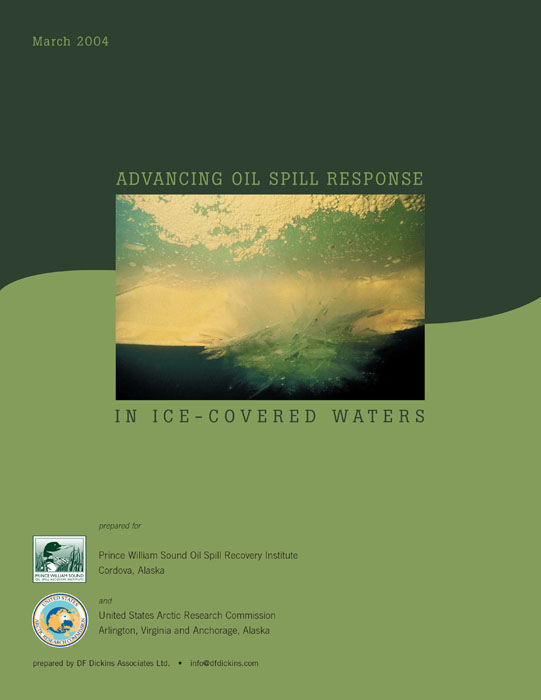
Advancing Oil Spill Response in Ice Covered Waters
for Prince William Sound Oil Spill Recovery Institute, 2002 to 2004
Dickins Associates created a research and development agenda for oil spills in ice-covered regions of the world, using the 2000 Oil and Ice Workshop proceedings (Chair: D. Dickins) as a starting point. Initial project areas and ideas were distributed to researchers around the world for comment and a final selection of priority areas made through an expert workshop in Anchorage, Nov 2003. The report was released jointly through the US Arctic Research Commission and Prince William Sound Oil Spill Recovery Institute in March 2004. Findings were presented at a special session on arctic spills at Interspill 2004 in Trondheim, Norway in June, 2004. The report is available at http://www.pws-osri.org/publications/OilIce_final.pdf

Tests to Determine the Limits of In-situ Burning of Thin Oil Slicks in Brash and Frazil Ice
subcontract to SL Ross Environmental Research (for MMS and Exxon/Mobil) 2002
Dickins participated in a field program using a test tank at Prudhoe Bay to evaluate the effectiveness of burning oil in slush and brash ice.
http://www.bsee.gov/Technology-and-Research/Oil-Spill-Response-Research/Projects/Project-452/
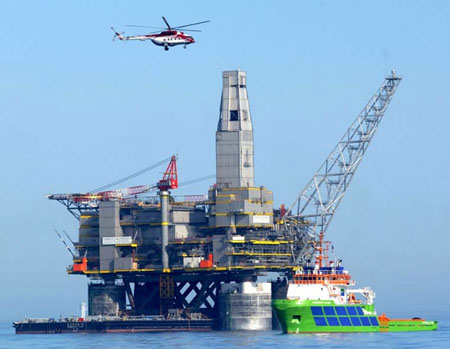
Photo: Fakhalin Enegery
Oil-in-Ice Spill Response Strategies: Sakhalin 2d Waters
for Sakhalin Energy Investment Corporation (subcontract to Polaris Applied Science) 200
This project recommended techniques to deal with spills in a variety of ice conditions found off the NE coast of Sakhalin Island. The document was used as input into contingency plans submitted for approval by the Russian regulatory agencies
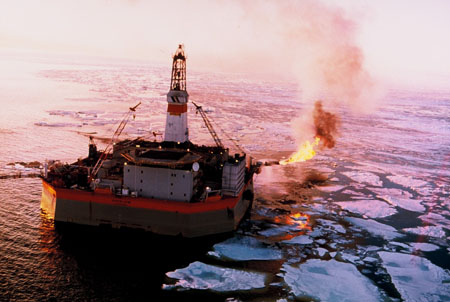
Photo: Gulf Canada Resources
Feasibility and Economic Review of Potential Oil-in-Ice Spill Response Techniques:
Sakhalin Oil Production and Transportation for an oil industry client, October 2001
This project examined possible new techniques to deal with spills in ice. Up to twelve different techniques (a mix of novel ideas and proven concepts) were evaluated against five scenarios involving platform, pipeline, terminal and tanker spills.

Photo: BSEE
Northstar Oil Spill Response
for BP Exploration (Alaska) Inc., 1996 -2001
The company prepared descriptions of oil spill fate and behavior, and response options for spill scenarios connected with both the production facility and pipeline operation. Work scope included participation in meetings with regulatory agencies and community organizations, and the development of discussion papers to develop spill response strategies in different seasons. Northstar entered production in 2001 as the first year-round arctic offshore oilfield in the world.
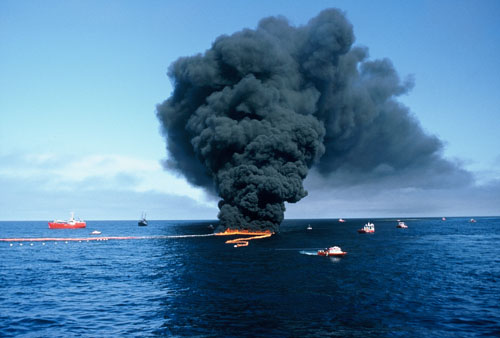
Photo: Environment Canada
Newfoundland Oil Burn Experiment (NOBE)
for Environment Canada, 1989 to 1993
This joint Canada/US project involved the first large-scale in-situ oil burning experiment on the open ocean. The burn was successfully carried out off Newfoundland in August 1993. Dickins contribution covered permitting, participation in public meetings, technical design, environmental assessment, and management support. The company monitored environmental conditions (air and ocean) during the experiment.
This project is still used as a key benchmark in assessing the environmental tradeoffs associated with in situ burning at sea.
Publications: Oil Spills
Oil Spill in Pack Ice
with S.L. Ross Environmental Research Limited for the Environmental Studies Research Funds, 1987
Dickins participated in three unique experimental spills conducted in dynamic pack ice conditions off Cape Breton Island in March 1986. The primary objective was to document the physical and chemical interaction of crude oil with pack ice.
Publications: Oil Spills
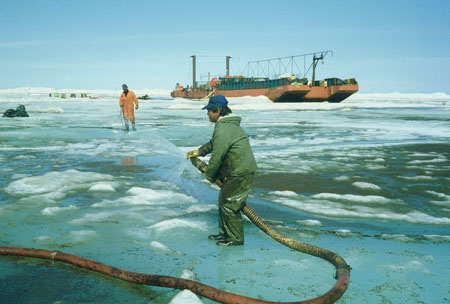
Environmental Atlas for Beaufort Sea Oil Spill Response
for Environment Canada, 1987
This computer-generated colour atlas was the first of its kind for any Arctic area and represented a major advance in terms of the sensitivity ranking, incorporating social, biological and oil behavior and persistence. The atlas synthesized environmental information relevant to the planning and implementation of year-round oil spill countermeasures in both coastal and offshore areas.

Oil Discharge Systems for the Baffin Island Oil Spill Project (BIOS)
for Environment Canada, 1980-81
BIOS was a twelve million dollar international experiment to assess the short and long-term fate and effects of oil stranded onshore compared to the impact of the same volume of oil when chemically dispersed into the nearshore environment. Dickins Associates designed and operated the systems used to discharge the oil. In addition, the company monitored beach processes along the shoreline through a series of time- lapse camera installations. Dickins was cited by Environment Canada for outstanding contract performance in this project. The BIOS project still forms a benchmark study for assessing the long term impacts of a spill on an arctic shoreline.
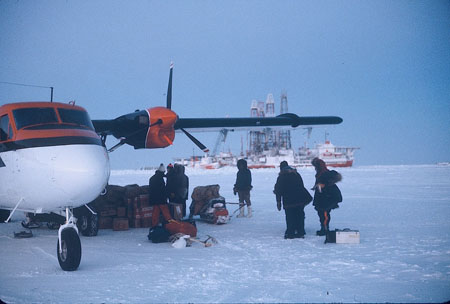
Oil and Gas Under Sea Ice
DF Dickins acted as Scientific Coordinator for Dome Petroleum Limited, 1979-1980 (now Amoco Canada Limited)
This work is unique among the relatively small number of significant field experiments involving crude oil in sea ice over the past 45 years as the only one to simulate a a subsea blowout under ice. The project involved three discharges of Prudhoe Bay crude and compressed air in shallow water beneath a sea ice sheet. Cleanup was accomplished by burning and mechanical removal.



